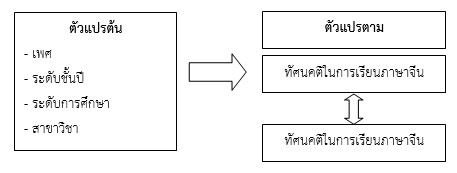Parisah Rakkuea Attitudes and Behaviors in Learning the Chinese Language by Students at Princess of Naradhiwas University
Main Article Content
Abstract
DOI : 10.14456/pnuhuso.2024.14
This research has two primary objectives: 1) to examine the attitudes and behaviors of students in the process of learning the Chinese language, and 2) to explore the correlation between these attitudes and behaviors within the student population of Princess of Naradhiwas University. The sample consisted of 92 students who registered for the Chinese language course during the first semester of the academic year 2023. The research instrument employed in this study is a questionnaire, with a high reliability coefficient of 0.967 as measured by Cronbach’s alpha. Data analysis involves computing the mean, standard deviation (S.D.), and Pearson correlation coefficient.
The research findings suggest the following:
1) Students' attitudes towards learning the Chinese language are generally at a high level (mean = 4.42, SD = 0.482), and their learning behaviors also exhibit a high level (mean = 4.10, SD = 0.691).
2) There is a statistically significant with positive correlation between overall attitudes and specific aspects of learning behaviors related to the Chinese language among students, observed at a significance level of 0.05.
Article Details

This work is licensed under a Creative Commons Attribution-NonCommercial-NoDerivatives 4.0 International License.
References
คณะศิลปศาสตร์ มหาวิทยาลัยนราธิวาสราชนครินทร์. (2566). หลักสูตร. https://libarts.pnu.ac.th/english-program/
ชูชัย สมิทธิไกร. (2561). พฤติกรรมผู้บริโภค. สำนักพิมพ์จุฬาลงกรณ์มหาวิทยาลัย.
ชูผิง เป้ย. (2558). ทัศนะของนักศึกษาต่อการเรียนการสอนวิชาภาษาจีน วิทยาลัยการแพทย์ ทางเลือก มหาวิทยาลัยราชภัฏจันทรเกษม. วารสารวิจัยทางการศึกษา คณะศึกษาศาสตร์ มหาวิทยาลัยศรีนครินทรวิโรฒ, 9(1), 44-55. https://ejournals.swu.ac.th/index.php/jre/article/view/657 0/6193
นริยา บุญมณีสิรีกุล. (2560). ทัศนคติต่อการเรียนวิชาภาษาจีนของนักเรียนชั้นมัธยมศึกษาตอนปลายโรงเรียนบางพลีราษฎร์บำรุง สังกัดสำนักงานเขตพื้นที่การศึกษามัธยมศึกษา เขต 6 [ปริญญานิพนธ์การศึกษามหาบัณฑิต, มหาวิทยาลัยบูรพา].
นุชจรีย์ หงษ์เหลี่ยม, นัดดา วงษ์วรรณา และพิราวรรณ หนูเสน. (2560). การศึกษาพฤติกรรมการเรียนของนักศึกษาแพทย์ชั้นปรีคลินิกปีการศึกษา 2559 คณะแพทยศาสตร์ ศิริราชพยาบาล. เวชบันทึกศิริราช, 10(3), 166-173. https://he02.tci-thaijo.org/index.php/simedbull/article/view/106234/84142
บุญชม ศรีสะอาด. (2560). การวิจัยเบื้องต้น (พิมพ์ครั้งที่ 10). สุวีริยาสาส์น.
ไพศาล สุขใจรุ่งวัฒนา. (2562). การศึกษาปัจจัยที่ส่งผลต่อพฤติกรรมการเรียนวิชาภาษาจีนของนักศึกษามหาวิทยาลัยมหิดล. วารสารมนุษยศาสตร์และสังคมศาสตร์ มหาวิทยาลัยธนบุรี, 13(1), 90-99. https://www.thonburi-u.ac.th/Journal/Document/13-1/Journal13_01_8.pdf
สำนักงานเลขาธิการสภาการศึกษา. (2559). รายงานการวิจัยเพื่อพัฒนาการเรียนการสอนภาษาจีนในประเทศไทย ระดับอุดมศึกษา. พริกหวานกราฟฟิค.
Assael, H. (1995). Consumer behavior and marketing action (5th ed.). Ohio: International Thomson Publish.
Bandura, A. (1986). Social foundations of thought and action: A social cognitive theory. Prentice-Hall.
Cronbach, L. J. (1990). Essentials of Psychological Test (5th ed.). Harper Collins.
Likert, R. (1967). The Method of Constructing and Attitude Scale. In Reading in Fishbeic, M (Ed.), Attitude Theory and Measurement (pp. 90-95). Wiley & Son.
Triandis, H. C. (2001). Attitude and attitude change. McGraw-Hill.
Weinstein, C. E. & Mayer, D.G. (1986). The teaching of learning strategies. In M.C.Wittrock (Ed.). Handbook of research on teaching (3rd ed.). Mcmilliam.
Yamane, T. (1973). Statistics : An Introductory Analysis (3rd ed.). New York: Harper & Row.


